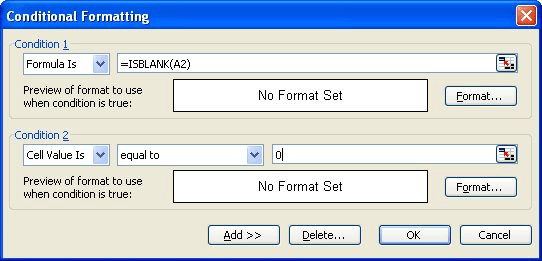Please Note: This article is written for users of the following Microsoft Excel versions: 97, 2000, 2002, and 2003. If you are using a later version (Excel 2007 or later), this tip may not work for you. For a version of this tip written specifically for later versions of Excel, click here: Conditional Formats that Distinguish Blanks and Zeroes.
Written by Allen Wyatt (last updated November 7, 2020)
This tip applies to Excel 97, 2000, 2002, and 2003
Let's say that you routinely import information from another program into Excel. The information contains numeric values, but it can also contain blanks. You might want to use a conditional format on the imported information to highlight any zero values. The problem is, if you just add a conditional format that highlights the cells to see if they are zero, then the condition will also highlight any cells that are blank, since they contain a "zero" value, as well.
There are several different solutions to this predicament. One solution is to apply a conditional format that uses two conditions. The first condition checks for the blanks, and the second checks for zero values. The condition that checks for blanks doesn't need to adjust any formatting, but the one that checks for zero values can. This works because if the first condition is satisfied (the cell is blank), the second condition is never tested. Do the following:

Figure 1. The Conditional Formatting dialog box after setting one condition.

Figure 2. The Conditional Formatting dialog box after setting two conditions.
Another solution is to combine your two conditions into a single condition. Follow these steps:
The formula used in step 4 checks to make sure that the value is 0 and that the cell is not blank. The AND function makes sure that only when both criteria are satisfied will the formula return True and the format be applied.
There are any number of other formulas that could also be used. For instance, each of the following formulas could be substituted in either step 5 or 4:
If you wanted an even faster way to highlight zero values while ignoring blanks, you might consider using a macro. The macro would be faster because you could just import and run it; you don't have to select a range of cells and enter the formula (or formulas) for the conditional formatting. The following macro is an example of one you could use:
Sub FormatRed()
TotalRows = 65000
ColNum = 1
For i = 1 To Cells(TotalRows, ColNum).End(xlUp).Row
Cells(i, ColNum).Interior.ColorIndex = xlAutomatic
If IsNumeric(Cells(i, ColNum).Value) Then
If Cells(i, ColNum).Value = 0 Then
Cells(i, ColNum).Interior.ColorIndex = 3
End If
End If
Next
End Sub
The macro checks the cells in column A. (It checks the cells in rows 1 through 65,000; you can modify this, if desired.) If the cell contains a numeric value and that value is zero, then the cell is filled with red. If the cell contains something else, then the cell is set back to its normal color.
Note:
ExcelTips is your source for cost-effective Microsoft Excel training. This tip (2980) applies to Microsoft Excel 97, 2000, 2002, and 2003. You can find a version of this tip for the ribbon interface of Excel (Excel 2007 and later) here: Conditional Formats that Distinguish Blanks and Zeroes.

Professional Development Guidance! Four world-class developers offer start-to-finish guidance for building powerful, robust, and secure applications with Excel. The authors show how to consistently make the right design decisions and make the most of Excel's powerful features. Check out Professional Excel Development today!
Conditional formatting can be used to draw your attention to certain cells based on what is within those cells. This tip ...
Discover MoreTired of the default colors that Excel uses to display the row and column coordinates? You can modify the colors, but ...
Discover MoreConditional formatting is a great feature in Excel. Unfortunately, you can't sort or filter by the results of that ...
Discover MoreFREE SERVICE: Get tips like this every week in ExcelTips, a free productivity newsletter. Enter your address and click "Subscribe."
There are currently no comments for this tip. (Be the first to leave your comment—just use the simple form above!)
Got a version of Excel that uses the menu interface (Excel 97, Excel 2000, Excel 2002, or Excel 2003)? This site is for you! If you use a later version of Excel, visit our ExcelTips site focusing on the ribbon interface.
FREE SERVICE: Get tips like this every week in ExcelTips, a free productivity newsletter. Enter your address and click "Subscribe."
Copyright © 2026 Sharon Parq Associates, Inc.
Comments